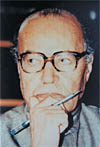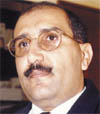Mohammed Akkoush: “Some tribes in Al-Mahara are quite democratic in their structures.” [Archives:1997/49/Interview]
Mr. Mohammed Salem Akkoush is currently a member of the Permanent Committee of the ruling People’s General Congress and a member of the Consultative Council. Originally from Al-Mahara, Akkoush, 55, occupied several ministerial and diplomatic posts in southern Yemen. He became the governor of Dhamar, the minister of agriculture, fisheries, and an ambassador to several African countries. He left Aden following the internal bloody conflict of January, 1986. Dr. Salah Haddash, Yemen Times Managing Editor, talked to Mr. Akkoush mainly about his home governorate of Al-Mahra, and filed the following interview.
Q: How is the current situation in Al-Mahara? A: As you may know, Al-Mahra is a remote border area. It borders Oman, and Saudi Arabia with a long desert line. It also has the largest coastal strip in Yemen, overlooking the Indian Ocean. In spite of this strategic position, Al-Mahara was neglected. Recently, however, some new projects were initiated and abandoned ones were restarted after the war of unity in 1994. So we can say now that Al-Mahara is better off than it was before. Public services, however, are still not functioning in a good way. There is still a lot to be done regarding the governorate’s infrastructure such as water, health, road, and education projects, especially in remote areas. There are very few asphalted roads connecting the center of the governorate with its smaller towns and villages.
Q: Are there any regular flights to and from AL-Mahara? A: There used to be 7 flights a week – 4 to Sanaa and 3 to Aden. Now there are only 2 flights a week, and even these are sometimes irregular. People now have to go on long waiting lists to get a flight to Sanaa or Aden.
Q: Is there any smuggling taking place along the border with Oman or Saudi Arabia? A: After the demarcation of the Yemen-Omani border line, smuggling has diminished considerably. The rough mountainous or desert terrain discourages potential smugglers. The smuggling operations that do take place are not significant. If there is an easing of customs restrictions and lowering of taxes it would become less worthwhile for people to smuggle goods.
Q: What sort of goods are usually smuggled? A: Smugglers usually bring cereals such as rice and luxury items such as clothes.
Q: What is the situation of women in Al-Mahara? A: Women in Al-Mahara have the best deal in all of the country. They are idolized by men. It is part of our heritage. Some women do not cover their faces, and can meet guests even if their menfolk are not present.
Q: Are young women in AL-Mahara able to get good education? A: The level of education in Al-Mahara is not bad. Most of our girls are now educated to the level of secondary school. Due to the increasing demand, the government is opening more secondary schools. There are now two co-educational secondary schools, one in Ghaidha and the other in Sayhoot. Many women are now starting to get employment.
Q: Are tribal allegiances still strong in Al-Mahara? A: Like in almost all other regions in Yemen, tribalism is still quite strong in Al-Mahara. Many people still follow their tribal customs and traditions. Tribal allegiances became rather weak during the rule of the totalitarian regime in the south, but they grew strong again. There around 150 tribes in Al-Mahara, not to forget the tribes living on the Island of Socotra which was part of the governorate of Al-Mahara. Tribalism, however, is not all bad. There are many redeeming characteristics such as generosity, courage, etc. Some tribes are quite democratic such as the Ziyad tribe, for instance. Members of this tribe elect a new sheikh every four years. This elected sheikh then chooses one figure from each of the tribe’s twenty clans, creating a kind of an advisory council. However, sheikhdom in other tribes is hereditary.
Q: How about blood feuds? Are they prevalent in Al-Mahara? A: Blood feuds still exist. When I became the governor of Dhamar immediately after independence in 1967, we solved many blood feuds through peaceful means. Tribes in general resort to unwritten rules and traditions to solve their feuds such as giving blood money or employing neutral mediators. When a settlement or reconciliation is reached, it is written down and is handed down the generations for the sake of an enduring peace. Another rule to limit blood feuds is that if a tribe violates the peace by killing a member of another tribe, then the latter is allowed to kill two members of the former. The renegade tribe is completely shunned by all other tribes.
Q: Is there any kind of environmental pollution in Al-Mahara? A: This is a very important issue. I met several senior officials about two months ago to discuss sewage pollution on the beaches whose contamination can be quite harmful to the fish wealth in the area. People and fishermen in particular are becoming more aware of the importance of preserving their environment. Public campaigns are now being conducted to collect rubbish and other pollutants from the beaches. Some types of fish which used to be discarded by fishermen and left to rot on the beach are now dried and used as cattle fodder. But the most pressing problem which can prove to be very difficult to solve is the oil slicks left behind by ships and oil tankers in particular which cross the Indian Ocean and the Arabian Sea.
Q: Remaining within the sphere of nature, what is the situation concerning wild life in Al-Mahara? A: Well, some gazelles, ibexes, tigers, leopards and birds of prey are still endemic, especially in the eastern region of Al-Mahara. During the rainy season from July to September, the mountains in the region connecting Al-Mahara with Dhafar in Oman become covered with a green carpet of grass. This is quite conducive for wild animals to come and graze in the area. There is actually a nature reserve in Oman near its border with Yemen where hunting is strictly prohibited, including the hunting of widely spread animals such as rabbits. In Yemen, however, it is open season all year round. Large numbers of animals have been smuggled from Yemen to some neighboring or even far away countries where they have become exhibits in natural history museums. Hunters from Oman and the UAE often cross the Yemeni borders feeling quite immune from prosecution. Many of them are indistinguishable from the rest of the people in the area. The “luban” or myrrh tree is endemic in the region between the mountains and the sea in Al-Mahara. The produce of this tree can become good source of income for the region, provided that more modern methods are adopted in extracting and producing myrrh. I call upon the Yemeni authorities to enforce a law protecting wildlife in Yemen before it is too late.
Q: What are the most urgent needs of Al-Mahara Governorate? A: The region’s priorities include first of all the construction of decent roads. For example, during the fishing season, the price of a kilo of good-quality fish in the coastal region would be around YR60 to YR90; while, in the hinterland, due to the rough terrain and lack of paved roads, the price of a kilo of fish could reach YR350 to YR600! Many people buy smuggled food stuffs such rice and sugar due to them being cheaper than if they were brought from a place like Hodeida, for instance. The availability of roads and accessibility again play a major part in this matter.
Q: How do you view the proposed administrative divisions? A: Al-Mahara is to remain largely as it is. Some directorates may become part of other governorates. The directorate of Ramah, for example, is considered an integral part of Al-Mahara, now its part of Hadhramaut and has been since the rule of the totalitarian regime in the south. It has a population of almost 25,000 people. I demanded many times that it should become part of AL-Mahara again. This will make life easier for its people. Instead of having to go to Mukalla, 9 hours’ drive away, to conclude their dealings with officialdom, they can go to Al-Mahara’s center of Al-Ghaidha, just 2 hours way by car. The Island of Socotra is now part of the Aden Governorate, but people living on that island belong to tribes in Al-Mahara.
Q: How well is Al-Mahara represented in parliament? A: There are actually two constituencies in Al-Mahara. Many parts of the region were cut away and incorporated within Hadhramaut during the rule of the Socialist Party. People participated fully in the last general elections. The problem is that there should be more constituencies and more representation. The Island of Socotra and other regions should become part of Al-Mahara Governorate.
Q: How serious is the problem of carrying firearms in Al-Mahara? A: Carrying firearms has become very widespread lately. Some people carry arms not for self defense, but as decorations, even though they may be submachine guns and pistols. Many sorry accidents take place, especially during marriage ceremonies when people fire many rounds in the air as a form of celebration. They often injure other people due to sheer negligence. People in Al-Mahara are ready and willing to give up their weapons, provided that other people in other parts of the country do the same.
Q: I understand that there is a unique Mahari dialect or even language. Could you tell us more about that? A: Some people in Al-Mahara, Socotra, and Salala in Oman speak the ancient Himyarite language. It is the language of Sabaa and Maeen. It is called “Jibalia” or mountain language, which is is different from Arabic. The language of the Socotra people, for instance, is a mixture of old Himyarite, Indian, and African languages. People living in remote and inaccessible mountainous regions can only speak the Mahari language.
——
[archive-e:49-v:1997-y:1997-d:1997-12-08-p:./1997/iss49/intrview.htm]


